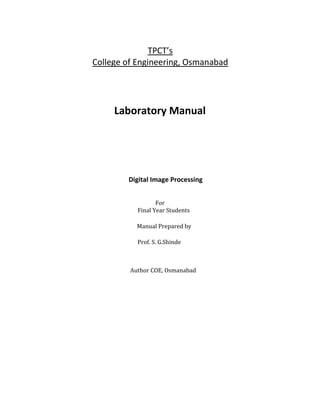This document contains information about a laboratory manual for a Digital Image Processing course. It includes the vision, mission, and objectives of the Electronics and Telecommunication department. It describes the contents of the laboratory manual, which contains practical lab sessions to enhance understanding of various aspects related to digital image processing. The document recommends that students thoroughly review the manual to better understand theoretical concepts in books through practical aspects.








![Pre-Lab
Introduction to MATLAB
Questions:
1] What do you mean by MATLAB?
2] Describe all MATLAB windows in detail.(command window, Graphics window ,
Editor window, Workspace, command history, current directory)
3] Describe all basic MATLAB command with example.](https://image.slidesharecdn.com/be-dip-lab-manual-220710160601-7181f5d8/85/BE-DIP-Lab-Manual-pdf-9-320.jpg)
![EXPERIMENT NO. 1
EXPERIMENT TITLE: Image Processing concept
AIM: To study the Image Processing concept.
OBJECTIVE: To study the Image Processing concept.
TOOLS REQUIRED: MATLAB
THEORY: Digital images play an important role both in daily life applications as well as in the
areas of research technology. The digital image processing refers to the manipulation of an
image by means of processor. The different elements of an image processing system include
image acquisition, image storage, image processing and display
An image is two dimensional function that represent a message of sum characteristics such as
brightness or color of viewed scene in the first mat lab program the command used from mat
lab is imcomplement
PROGRAM:
% Program to study the image processing concept
I=imread('pout.tif');
J=imcomplement(I);
figure,imshow(I)
figure,imshow(J)
K=imadjust(I,[0;0.4],[0.5;1])
figure,imshow(K)
Result:](https://image.slidesharecdn.com/be-dip-lab-manual-220710160601-7181f5d8/85/BE-DIP-Lab-Manual-pdf-10-320.jpg)

![EXPERIMENT NO. 2
EXPERIMENT TITLE: Histogram equalization image
AIM: To obtain histogram equalization image.
OBJECTIVE: To obtain histogram equalization image.
TOOLS REQUIRED: MATLAB
THEORY: Histogram equalization is a method in image processing of contrast adjustment
using the image's histogram. Histogram equalization often produces unrealistic effects in
photographs; however it is very useful for scientific images like thermal or x-ray images,
often the same class of images to which one would apply false color. Also histogram
equalization can produce undesirable effects when applied to images with low color depth.
For example, if applied to 8-bit image displayed with 8 bit gray scale it will further
reduce color depth (number of unique shades of gray) of the image. Histogram equalization
will work the best when applied to images with much higher depth than palette size,
like continuous data or 16-bit gray-scale images.
PROGRAM:
% Program to obtain histogram equalization concept
I=imread('trees.tif');
J=imcomplement(I);
imhist(J,100);
imshow(I);
title('original');
figure,imshow(J);
title('complement');
I=histeq(I);
figure,imhist(I,64);
title('equilized');
figure,imhist(J,64);
title('histogram');
n=numel(I);
p=imhist(I)/n;
figure,plot(p);
title('normalized');
K=imadjust(I,[0;1],[0.4;1],0.5);
figure,imshow(K);
title('adjusted image');
T=maketform('affine',[.3 0 0;.5 1 0;0 1 1]);
tformfwd([0,0],T);
I2=imtransform(I,T);
figure,imshow(I2);
title('forward image');](https://image.slidesharecdn.com/be-dip-lab-manual-220710160601-7181f5d8/85/BE-DIP-Lab-Manual-pdf-12-320.jpg)












![EXPERIMENT NO. 8
EXPERIMENT TITLE: Erosion and Dilation
AIM: Program for morphological operation: erosion and dilation.
OBJECTIVE: Program for morphological operation: erosion and dilation.
TOOLS REQUIRED: MATLAB
THEORY: Erosion (usually represented by ⊖
) is one of two fundamental operations (the
other being dilation) in morphological image processing from which all other
morphological operations are based. It was originally defined for binary images, later being
extended to grayscale images, and subsequently to complete lattices.
With A and B as two sets in Z2 (2D integer space), the dilation of A and B is defined as
A(+)B={Z|(B ̂)Z∩A ≠ ɸ}
In the above example, A is the image while B is called a structuring element.
In the equation,(B ̂)Z simply means taking the reflections of B about its origin and shifting it
by Z. Hence dilation of A with
B is a set of all displacements, Z, such that (B ̂)Z and A overlap by at least one element.
Flipping of B about the origin and then moving it past image A is analogous to the
convolution process. In practice flipping of B is not done always.
Dilation adds pixels to the boundaries of object in an image. The number of pixels added
depends on the size and shape of the structuring element. Based on this definition, dilation
can be defined as
A(+)B={{Z|(B ̂)Z∩A} ϵ A}
PROGRAM:
% Program for morphological operations: Erosions& Dilation
f=imread('coins.png');
B=[0 1 1;1 1 1;0 1 0];
f1=imdilate(f,B);
se=strel('disk',10);
f2=imerode(f,se);
figure,imshow(f)
title('input image');
figure,imshow(f1)](https://image.slidesharecdn.com/be-dip-lab-manual-220710160601-7181f5d8/85/BE-DIP-Lab-Manual-pdf-25-320.jpg)







